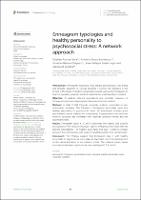Mostrar el registro sencillo del ítem
Enneagram typologies and healthy personality to psychosocial stress : a network approach
| dc.contributor.author | Ramos Vera, Cristian | |
| dc.contributor.author | Serpa Barrientos, Antonio | |
| dc.contributor.author | Baños Chaparro, Jonatan | |
| dc.contributor.author | Vallejos Saldarriaga, José Francisco | |
| dc.contributor.author | Saintila, Jacksaint | |
| dc.date.accessioned | 2023-01-18T21:37:01Z | |
| dc.date.available | 2023-01-18T21:37:01Z | |
| dc.date.issued | 2022 | |
| dc.identifier.uri | https://www.frontiersin.org/articles/10.3389/fpsyg.2022.1051271/full | |
| dc.identifier.uri | https://hdl.handle.net/20.500.12692/104649 | |
| dc.description.abstract | Introduction: Enneagram typologies may impact psychological well-being and stressful situations in college students. However, the literature is still limited in the study of dynamic personality models such as the Enneagram in Spanish-speaking university students, and a better understanding is needed. Objective: To analyze network associations and centrality measures of Enneagram personality typologies in Peruvian university students. Methods: A total of 859 Peruvian university students responded to two instruments assessing: The Pangrazzi’s Enneagram personality types and healthy personality to psychosocial stress. All instruments showed good psychometric values (validity and consistency). A regularized cross-sectional network structure was estimated with Gaussian graphical model and the graphical LASSO. Results: Enneagram types 4, 5, and 6 presented the highest and positive associations in the network structure. Type 6 emerged as the node with the highest predictability. The healthy personality and type 7 acted as bridges between the communities, with types 6, 7, and 8 being the most central nodes. Conclusion: The findings suggest that Enneagram type 7 with healthy personality to psychosocial stress plays an important role in the development of the causal activation of the network model. The network shows causal associations between psychosocial stress and types 6, 7, 8, and 9. | es_PE |
| dc.format | application/pdf | es_PE |
| dc.language.iso | eng | es_PE |
| dc.publisher | Frontiers Media SA | es_PE |
| dc.relation.ispartofseries | Frontiers in psychology;24 Nov. 2022 | |
| dc.relation.uri | https://www.frontiersin.org/articles/10.3389/fpsyg.2022.1051271/full | es_PE |
| dc.rights | info:eu-repo/semantics/openAccess | es_PE |
| dc.rights.uri | https://creativecommons.org/licenses/by/4.0/ | es_PE |
| dc.source | Repositorio Institucional - UCV | es_PE |
| dc.source | Universidad César Vallejo | es_PE |
| dc.subject | Estrés (Psicología) | es_PE |
| dc.subject | Personalidad | es_PE |
| dc.subject | Estudiantes universitarios | es_PE |
| dc.title | Enneagram typologies and healthy personality to psychosocial stress : a network approach | es_PE |
| dc.type | info:eu-repo/semantics/article | es_PE |
| dc.description.sede | Lima Norte | es_PE |
| dc.identifier.doi | https://doi.org/10.3389/fpsyg.2022.1051271 | |
| dc.subject.ocde | https://purl.org/pe-repo/ocde/ford#3.02.00 | es_PE |
| dc.publisher.country | PE | es_PE |
| dc.description.lig | Biodiversidad, cambio climático y calidad ambiental | es_PE |
| dc.description.rsu | Promoción de la salud, nutrición y salud alimentaria | es_PE |
| dc.description.ods | Fin de la pobreza | es_PE |
Ficheros en el ítem
Este ítem aparece en la(s) siguiente(s) colección(es)
-
Lima Norte [97]


